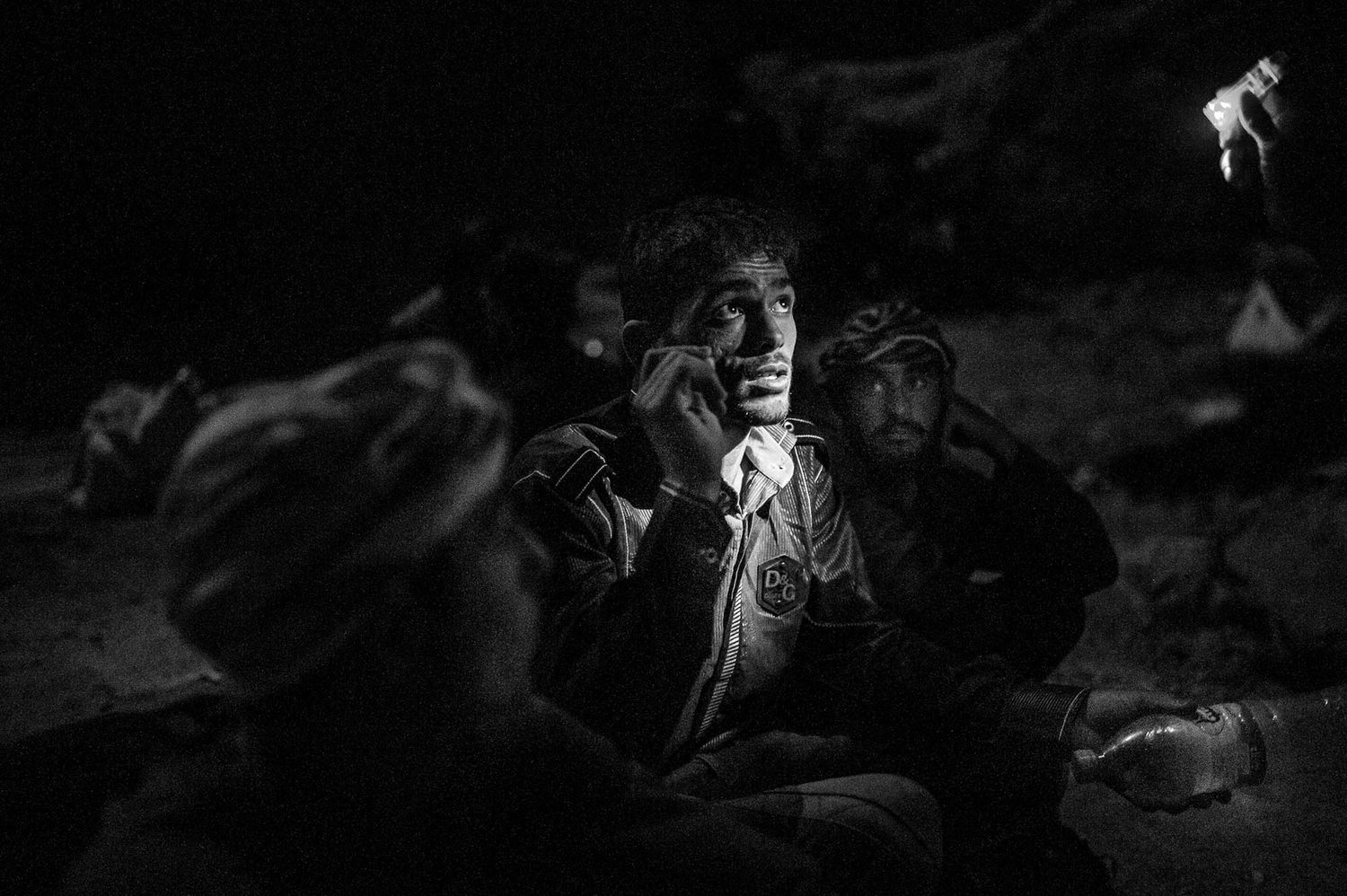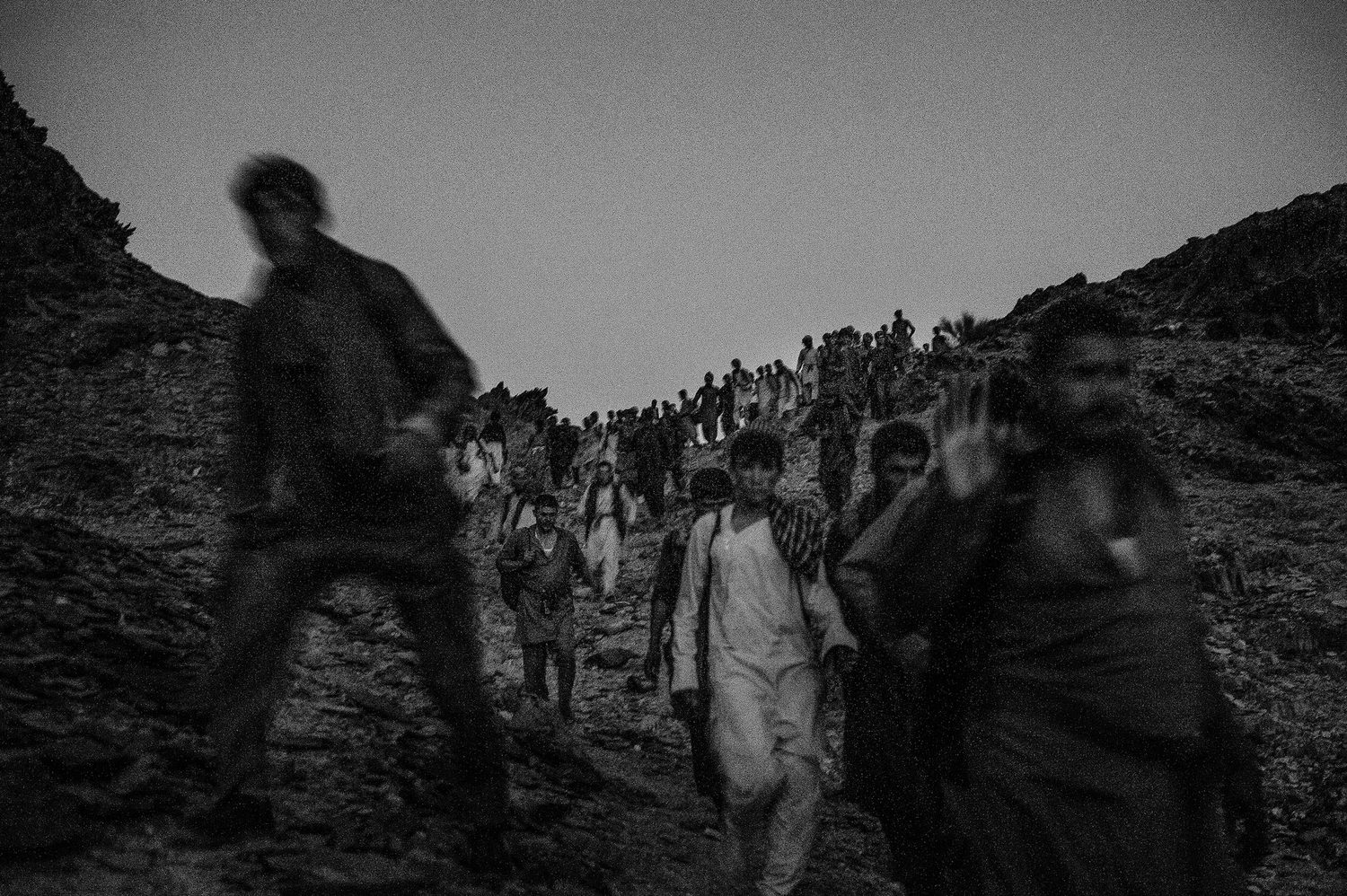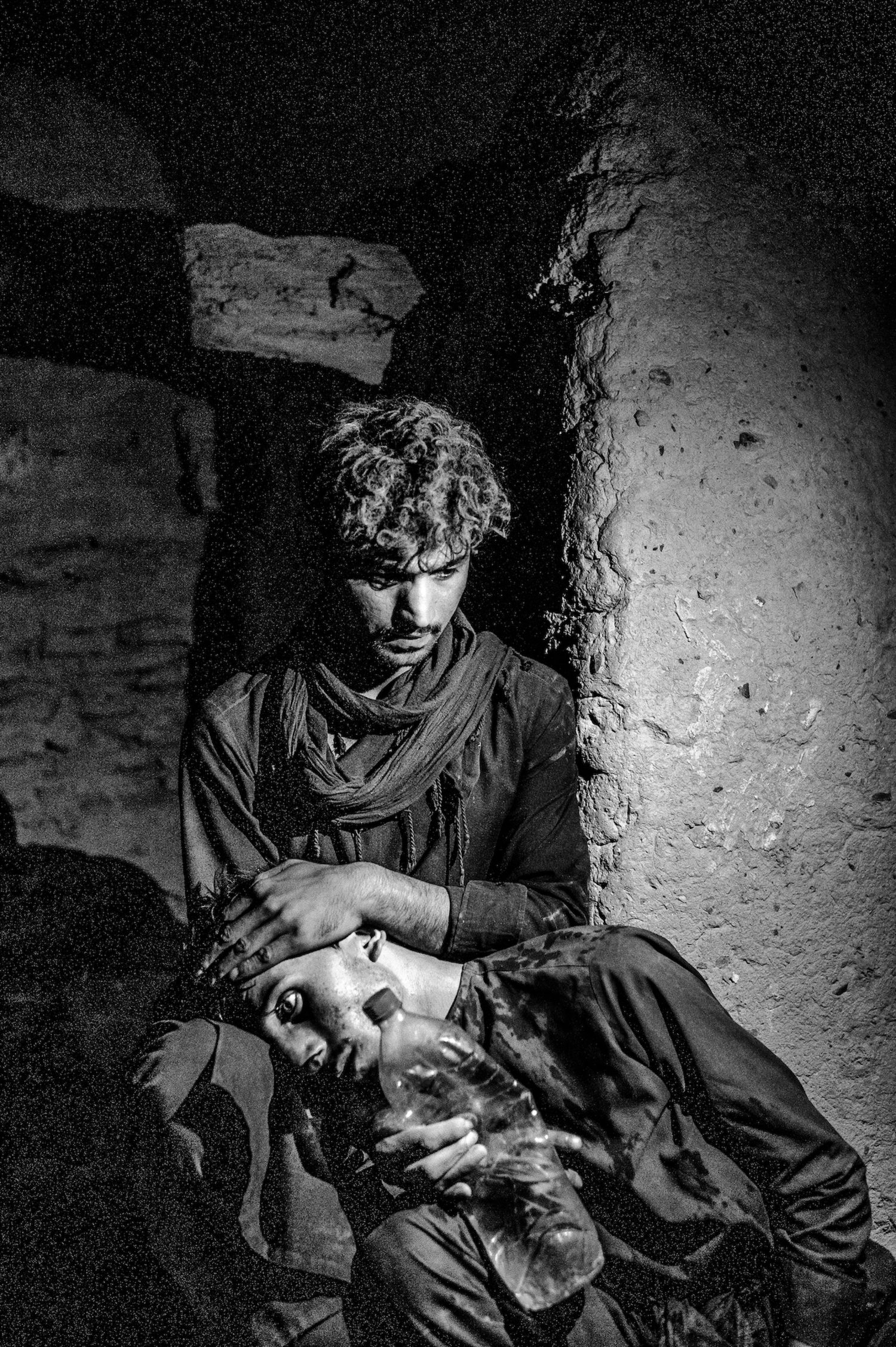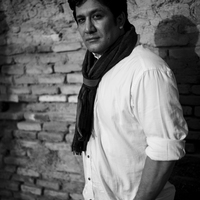The Iranian border with Afghanistan is host to a number of critical transit routes for Afghan migrants fleeing the perpetual danger of daily life. Since these routes are unregulated, they are constantly host to new forms of danger and coercion, primarily at the hands of a network of mules who relentlessly carry out looting, kidnapping and human trafficking. Because these zones are so dangerous, they are rarely reported on, and even more infrequently photographed.
Initially trained as an engineer, Enayat Asadi started teaching himself photography in 2009, and became increasingly interested in documenting issues surrounding poverty, injustice and social discrimination in Southeast Asia. This led him to pursue stories about Afghan refugees and the problems associated with illegal immigration. In 2017, he travelled to Baluchistan province, on Iran’s eastern border, to create photographic documentation of the volatile events happening there on a daily basis. His resulting project is titled Rising from the Ashes of War, and acts as stark documentation of an underrepresented reality.
In this interview for LensCulture, Asadi speaks about his journey to Baluchistan, how he gained access to photograph such dangerous events, and how he hopes the stories in his photographs will be preserved.

Cat Lachowskyj: What did your first photographic projects look like? How did they evolve into the work you do now?
Enayat Asadi: In 2010, I completed my first project, which is called Striving for Life. Then, in 2011, I travelled to Afghanistan to document the war for a few months, and upon returning from that trip, I stopped making photographs. I didn’t return to the medium until 2017.
My photographs are definitely influenced by the way I grew up and the impact that family and community have on me—I carry that with me in each project. My works are a reflection of the fears, hopes, beliefs and ideals I carried throughout different decades of my life. My personal work draws on specific issues that are mentally chaotic. As photographers, the pictures we make are images of ourselves, not of the people we photograph. Photographers decide how to define the world through the direction of our own vision. For me, photography is like storytelling, which is the most powerful form of art.

CL: How did you first approach making the images in Rising from the Ashes of War? When did you first go to Baluchistan and the eastern border, and what were your initial impressions?
EA: I first went to the border in May 2017. I believe in immersing myself in the environment where I make photography. I approach things slowly, step by step, because it’s very difficult to gain the trust of people at the eastern border. It’s a volatile situation, and the people who live there spend their lives working in fuel, human and drug trafficking.
I was in touch with three groups, and each of them paved the way for me. The most important thing for them to understand about me was that I was not part of some sort of government intelligence agency. I was always worried about being arrested by Iranian intelligence forces myself, and losing the photos I made along my journey. Since I didn’t have a lot of money, I had to live in the cheapest places I could find, like public hostels with ten to fifteen people sleeping in a single room. This actually gave me the opportunity to meet many people from the lower classes of society, and with their help, the project began.

CL: What kind of difficulties did you encounter as an outsider?
EA: I visited every place that I heard was a path for refugees to cross, and I started looking for ways to get in touch with the smugglers, but you cannot reach anyone without the help of mutual friends. So, I would wait for a month or so in each small town or village, and my initial problems would begin all over again, because I was a stranger to those communities at first , and I always seemed suspicious. To get to know people, I would start photographing during the day. Many drug addicts, homeless people and drug dealers knew who I was because they saw me in different parts of the city each day.
At one border point in particular, I was permitted to enter the homes of the smugglers, and at another point I was only allowed to photograph briefly, and had to leave the area quickly. Many people work in human trafficking, and everyone carries out a different task. There are secret house watchers, drivers, police informers who report which roads can be safely passed through, and informers who were stationed at road checks, or who sell water and food to refugees in the city. I spoke to all of these people, and as our friendships strengthened, I was able to be present in each of these situations to record this unseen part of history.

CL: Why are refugees crossing into Iran from Afghanistan?
EA: The Middle East is a place of insecurity and unrest, and in areas where there is bloody conflict, extremist and violent cults are often formed. The Afghan refugees have often been forced into trafficking illegally due to the bitter and severe consequences of several years of violence, insecurity and poverty.
CL: What is the relationship like between the refugees and the smugglers? What was it like to witness these interactions?
EA: There is nothing respectable happening throughout this process. Smugglers treat refugees like sheep, and consider themselves to be shepherds. Any behavior that would crush human pride is carried out. But for the refugees, there is only one goal: to survive. Hope is the only thing that I saw within them.

CL: What does a typical day or night look like at one of these crossings?
EA: The first time I entered an area, it was noon. The atmosphere of sorrow and grief was incredibly palpable. I didn’t have any knowledge about this area—about how the people would deal with me—but my outfit was quite similar to the locals. I entered a palm grove where there were two sheds, and inside one of them there were two men—one Pakistani and one Baluch. They looked at me with amazement because I did not speak in their dialect. I explained what I was doing there, and we talked for over an hour.
At 3 o’clock in the afternoon, another man joined us, and his intense stares made the atmosphere feel heavier, but honesty is always the best way to communicate. I spoke to him about my reasons for being there. He never responded to me, and eventually left with two other men who arrived. As the sky darkened, more people started showing up—pick-up trucks started arriving. At 8 o’clock, the man who wouldn’t speak to me returned. His phone kept ringing and he was speaking to multiple different people—perhaps fifty different contacts. He was the master of the area, and was in command of everyone. Each refugee passage was guarded by people who were constantly checking to see if the paths were clear.

At around 10 o’clock, the men gathered for dinner. During that time, they asked me a lot of questions. They were very suspicious of me, and thought I was a spy. A few months after that evening, they confessed that they had wanted to kill me and stage it as an accident. At midnight, the activity and bustle increased. At 12:30 in the morning, we started hearing more sounds. I realized that refugees had entered the area—around 350 people. I asked permission to see where they had emerged, and I entered the palm grove.
It was an unbelievable sight. Everyone was thirsty and begging for water, and each bottle was being sold to them for ten times its actual price. The smugglers were telling everyone to be quiet, threatening violence. The atmosphere was strange, and everyone’s face had a look of astonishment on it, especially the teenagers.
All of this happened in absolute darkness. Only a small flashlight was being used to identify the refugees and get money out of them. Beating, threatening and swearing at them was normal behavior. Slowly, cars started to arrive and everyone had to ride away quickly. There was a smoky gasoline tank in each car to facilitate escape from the police. At 4 o’clock in the morning, everyone was gone. During this entire time, I was not allowed to photograph—I simply witnessed the events. After three days of observation, despite the severe security measures of the Iranian intelligence forces, I was able to shoot my first photo of a refugee on the border.

CL: How long did you stay at the border during that initial journey, and how many times have you returned since then?
EA: I lived in Sistan and Baluchistan province for almost two years, and I would journey to the border intermittently for anywhere between 15 to 30 days at a time. In Iran, human traffickers are imprisoned for anywhere between two to ten years, along with seizure of their vehicles and cash. These heavy punishments make people suspicious of who they are dealing with, which is why I decided to live there long-term to earn their trust.
CL: What compelled you to document the migrants with your camera?
EA: I had visited Afghanistan in 2011, so was aware of the struggles that Afghan people face, but living in Baluchistan province is what motivated me to pursue this project photographically. It took time and patience.

CL: Why do you choose to work in black and white?
EA: For me, black and white highlights the perspective of hope and hopelessness, which is what I am trying to convey through my photographs. Monochrome images also possess more powerful elements of abstraction and symbolism, which has a particular visual effect on me.
CL: Your images also range from startlingly clear and striking shots to blurred moments, conveying the confusion that you described coursing through the atmosphere of the border. What methods did you use to make these images, and how did you figure out the best aesthetic for telling this story?
EA: I don’t have a pointed way of answering this question, but at the time, the only thing on my mind was trying to survive, and that heightened sense of survival may be the reason for why the pictures turned out ‘beautiful’. That sense of commonality with the refugees allowed me to be a part of that space with the people there. In my opinion, there is no pattern or law for making art—you have to free yourself through it.

CL: Why do you think making these photographs was important, not only for you personally, but also in a historical sense?
EA: My duty is to photographically document the human beings in a path of crisis that needs attention. I know that with only one single project, the lives of millions of refugees won’t completely change forever, but I still think it’s important to document this history. I believe that documentary photography is a powerful tool to inform and challenge people on a personal and intimate level. Additionally, images can catalyze direct action from passionate and committed individuals, as well as governments, policy-makers and pertinent organizations.
CL: What do you hope to achieve through this work? What do you want viewers to understand through your images?
EA: Photography plays a fundamental role in alerting and sensitizing the public in a straightforward, pungent way that no other medium is capable of. I hope to bring the story of those who are ignored and forgotten by society into people’s daily lives. I want to make people aware of the problems that exist, and have then take their own position on the matter.
Editor’s note: Enayat Asadi won the second place for a single image from this series in the LensCulture Black & White Awards 2019. Take a look at all of the winners and finalists to discover others photographers from around the world making inspiring monochrome work.










